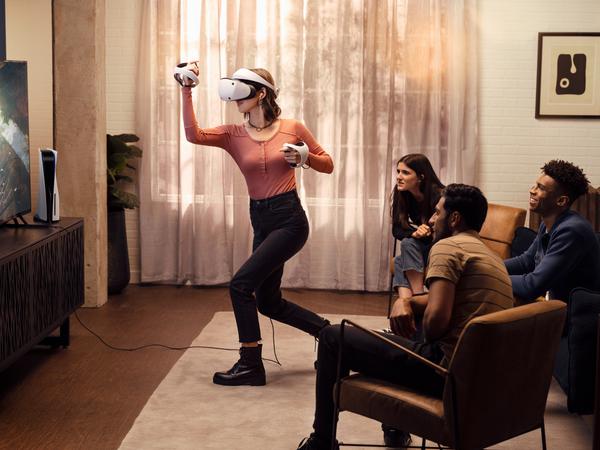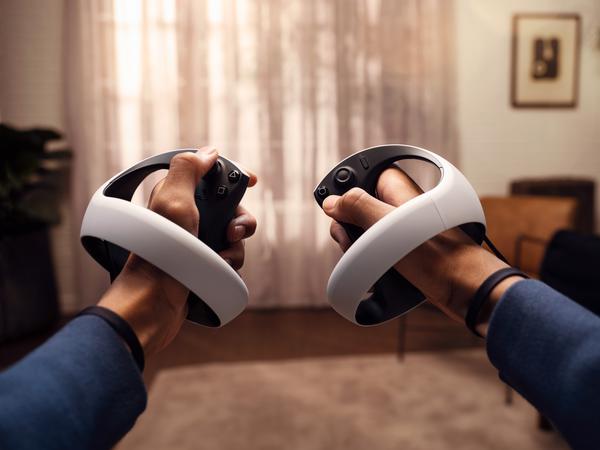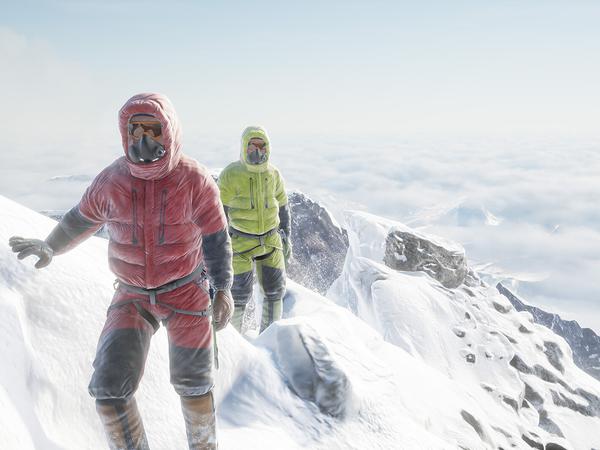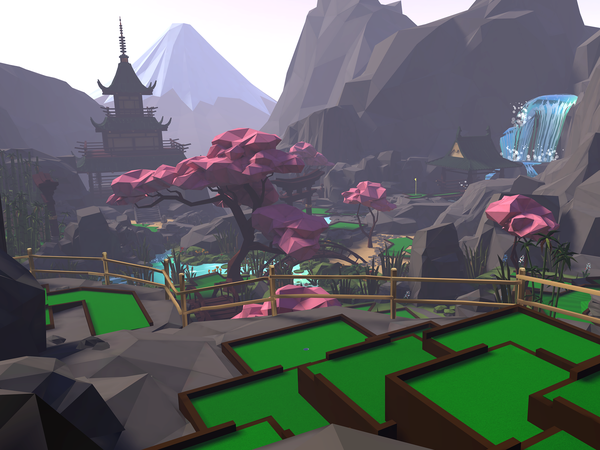The canoe glides through the crystal clear water. To the left and right of the river is dense, deep green rainforest, the sun shines through the treetops, you can fish individual leaves out of the water with your hand. Suddenly there is a loud crunch, the trees lean to the side – and a towering dinosaur bursts out of the green. His thick pillared legs narrowly miss the boat as he leisurely crosses the river – and disappears back into the jungle.
The nerve-wracking scene comes from a computer game. It’s called “Horizon Call of the Mountain” and is something like the workhorse of Sony’s new virtual reality headset “Playstation VR2”. The PS VR 2, as it is called, came onto the market worldwide in February – and ensures that virtual reality continues to gain popularity.
In Horizon Call of the Mountain, explore a mountain and jungle world populated by massive robotic dinosaurs; you fight with bow and arrow or swing over dizzying abysses. The PS VR2 sits in front of the eyes like ski goggles, a high-resolution display shows two parallel images that the human brain puts together to create the illusion of a three-dimensional world.

Unlike conventional computer games, you feel right in the middle of the action, you can look around by turning your head and use the controller to fight, climb or lift objects. A bit like in Steven Spielberg’s science fiction film “Ready Player One” – or like in the TV series “Periphery” on the streaming service Amazon Prime. In order to be able to use the glasses, you need an area of at least four square meters at home – on which a “virtual enclosure” is set up by means of an environmental scan, in which you can move freely.
The hardware is expensive – but that is slowly changing
So far, so futuristic. However, the PS VR 2 is far from the only virtual reality glasses on the market. Quest 2 from Facebook parent company Meta, which is estimated to have sold around 15 million copies worldwide, is particularly popular with private users; the follow-up model, Quest 3, is scheduled to appear later this year.
Another provider is the Pico company from the Chinese group Bytedance (TikTok), which recently released the Pico 4 headset in Germany. All of these VR glasses are not exactly cheap: the Quest 2 and the Pico 4 cost a good 400 euros in the basic version, the PS VR2 even 600 euros. While Quest 2 and Pico 4 work wirelessly, the PS VR2 has to be connected to a Playstation 5 by cable – which then also calculates particularly beautiful VR graphics. However, the cable can prove to be a tripping hazard in the living room.

Virtual reality is not really a new technology: the first bulky headsets appeared as early as the 1990s, which were still much more expensive at the time. There are several reasons why VR has been a niche for a long time: the high hardware costs, the low wearing comfort, the “motion sickness” (some users get sick quickly) – and the fact that there was a lack of spectacular software.
But that is now changing: the devices are becoming cheaper and slimmer, the VR apps are becoming more convenient and versatile. Blockbusters like “Horizon Call of the Mountain” may be the focus at the moment – but there are now countless games and apps for everyday use. An overview.
fitness
During the pandemic, VR sports experienced a significant upswing: gyms were closed, people trained at home instead – and increasingly used their virtual reality headsets for this. There is now an impressive range of sports and fitness apps.
You can shadow box to music in the virtual gym, but you can also climb into the boxing ring with other VR users online. There is tennis, table tennis and squash, as well as bowling, rock climbing, archery, football and baseball. If you want, you can hit the dance floor in a virtual club or relax with Tai Chi and meditation exercises in the virtual park. The “VZfit” app, which integrates the home ergometer via a motion sensor, is very sophisticated: For example, you can virtually pedal the Tour de France or cycle across the USA.
By far the most popular fitness game, however, is “Beat Saber”: In the rhythm game, the task is to break up flying blocks with laser swords in time to the music. This proves to be quite sweaty – and puts users in a real flow.
Travel
This app category also made it big in the pandemic. In times of restricted travel, more and more people are using virtual tourism to at least partially satisfy their wanderlust. Or even to plan future trips.
The most well-known app of this type is “Google Earth VR”: The search function teleports you to almost any location around the world, whether it’s Times Square in New York, the pyramids in Gizeh or the ruined city of Machu Picchu. There you can then stalk around to your heart’s content – although the environment is static because Google puts it together from satellite and street view data. The “Wander” app works in a similar way, but is easier to use and has additional features such as virtual sightseeing tours.

There are also apps that focus on very specific travel destinations: for example Mount Everest, various national parks or the moon. Yes, you read that right: The successful but technically extremely delicate moon mission from 1969 can be recreated in VR – from the rocket launch to the famous “big step for mankind”.
action games
A hearty action film can be quite nice. But wouldn’t it be great to step into the role of an action heroine yourself? VR apps like the aforementioned Horizon Call of the Mountain offer just that: adrenaline-pumping adventures in which you explore fantastic landscapes, find treasures and defeat villains. For a long time, such epic adventures on VR glasses were the exception, simply because their production is very complex and expensive.

In the meantime, however, there are some action-adventures that promise hours of varied fun – in the Star Wars universe, in a mouse wonderland, the zombie apocalypse or in a dystopian surveillance state. Some of these worlds can even be explored together with other VR users.
board games
Those who like it a bit quieter will also get their money’s worth in VR. For example, “Walkabout Mini Golf” is very relaxing and offers extravagant locations (submarine, spaceship, Babylonian gardens, etc.) and different levels of difficulty.

The highlight: Up to four players can network online here – and then, eagerly talking shop, play a few rounds.
The “Demeo” app offers a similar feeling of closeness: Here, several people sit around a virtual gaming table and drag fantasy figures through dungeons and catacombs infested with monsters – the cult hobby cellar from the TV series “Stranger Things” says hello!
study and work
VR is already being used in a number of professional fields, whether in architecture, medicine or engineering. Anyone who would like to continue their education as a private person with virtual reality will also find a lot of exciting learning apps and simulations. Anyone who suffers from stage fright during presentations, for example, can practice such situations with “VirtualSpeech”.
Other apps simulate everyday life simulations to test our foreign language knowledge. In addition, there are plenty of VR applications that impart knowledge in a very specific way – for example from astronomy, anatomy or history. There are also virtual co-working spaces such as “Horizon Workrooms” or “Spatial”, where work colleagues meet in avatar form. Although that sometimes seems a bit silly.
Arts and Culture
Do you want to let off steam creatively? Here, too, virtual reality has a lot to offer. In “Tilt Brush”, for example, luminous, walk-in paintings are created – the whole thing is a kind of Photoshop in three dimensions.
Other apps have specialized in pottery or sculptures, some of which can also be worked on together. Even graffiti artists can spray walls in VR to their heart’s content without immediately getting into trouble with the public order office. Even those who just want to enjoy art will soon find what they are looking for in VR: there are now numerous museums that present their exhibits virtually – and also bands that give virtual concerts.

Thinking outside the box
How does it feel to live in a war zone? How does a psychosis manifest itself? And how is it to live in an isolation cell with a floor area of just a few square meters? Virtual reality does not claim to represent these experiences one-to-one – that would just be presumptuous. And yet the immersive power of such apps gives at least a rudimentary idea of how those affected feel in such life situations. An excellent example is “Anne Frank House VR”: the faithfully furnished rear building where the Jewish girl hid from the Nazis between 1942 and 1944.
Note: Not all apps mentioned are available on all VR devices. In addition, the use of virtual reality is only recommended from the age of 13, because children’s eyes and brains first have to learn to see in three dimensions – VR can lead to impairments here.
To home page

